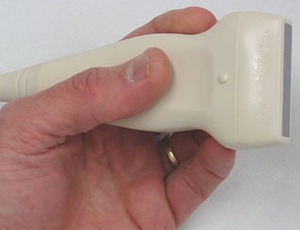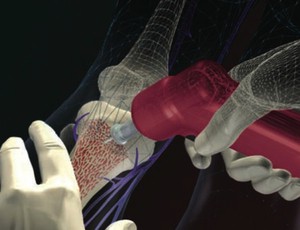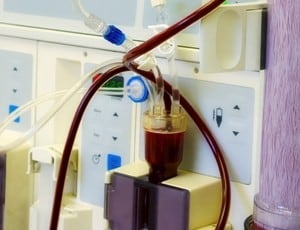Long-term central venous catheters versus transhepatic venous catheters in infants

Without compromising future central venous access sites, transhepatic venous lines had superior duration of service without increased thrombosis, thrombolytic use, or insertion site complications relative to central venous lines. Transhepatic venous catheters had a higher infection rate, and further investigation into the etiology is warranted” Marshall et al (2017). Abstract: OBJECTIVES: Children with congenital heart […]
Absence of right internal jugular vein during central venous cannulation

Although the right neck was thoroughly examined via USG, the right IJV was absent” Erdoğan et al (2017). Extract: “The patient was covered in a sterile way and 9-L linear probe of USG (5.0–13.0 MHz, multi-frequency, boardband) was sterilised and placed in the right neck region, but the right IJV was not visible. While the […]
How to reduce premature infants’ pain during venipuncture

In this study, we aimed to identify the effect of covering the eyes and playing the intrauterine ambient sounds on premature infants’ pain and physiological parameters during venipuncture” Alemdar and Özdemir (2017). Abstract: BACKGROUND: There is a need to assess the impact of initiatives to reduce exposure to environmental light and sound in preterm infants […]
Ultrasound for locating PICC tip position in neonates

This study was done to compare the effectiveness of real-time ultrasound (RTUS) with X-ray in identifying the peripherally inserted central catheter (PICC) line tip” Telang et al (2017). Abstract: BACKGROUND & OBJECTIVES: Securing long-term venous access is an essential part of sick newborn care. The malposition of central line tip leads to several complications. There […]
Importance of sonography for central venous cannulation in patients with neurofibromatosis
The importance of analyzing sonographic images of nerve sheath tumours, which can mimic blood vessels, and the importance of Doppler ultrasound for guiding central venous catheters in such patients to avoid nerve injury are discussed in this case report” Mohan and Nisa (2017). Abstract: A 15-year-old boy with neurofibromatosis type 1 (NF1) was referred to […]
Ultrasound-guided cannulation of the brachiocephalic vein in children
Ultrasound-guided (USG) cannulation of the brachiocephalic vein (BCV) has been shown to be technically easy. We hypothesised that adoption of USG in-plane cannulation of the BCV as the primary approach to central venous cannulation at our institution would lead to central venous cannulation for a greater variety of indications” Thompson (2017). Abstract: OBJECTIVE: Ultrasound-guided (USG) […]
Guidelines for the provision of nutrition support in the pediatric critically ill patient

This document represents the first collaboration between 2 organizations-the American Society for Parenteral and Enteral Nutrition and the Society of Critical Care Medicine-to describe best practices in nutrition therapy in critically ill children” Mehta et al (2017). Abstract: This document represents the first collaboration between 2 organizations-the American Society for Parenteral and Enteral Nutrition and […]
Comparison of the performance and survival of two different tunnelled haemodialysis catheters

We sought to determine which of two tunnelled HDCs, DuraMax® (Angiodynamics, NY, USA) or SplitCath® (MedComp, PA, USA) delivers the best performance, safety and reliability for dialysis patients” McGarry et al (2017). Abstract: Background: Despite their well-recognised shortcomings, haemodialysis catheters (HDCs) remain an important form of haemodialysis access for many patients. There are several HDCs […]
Dosing considerations for daptomycin in adult patients with haematological malignancies

To assess the population pharmacokinetics (popPK) of daptomycin at the conventional dose of 6 mg/kg/day in a cohort of oncohaematological patients” Cojutti et al (2017). Abstract: Objectives: To assess the population pharmacokinetics (popPK) of daptomycin at the conventional dose of 6 mg/kg/day in a cohort of oncohaematological patients. [ctt link=”mg91Y” template=”1″]ReTweet if useful… Dosing considerations for daptomycin […]
Soft tissue laceration caused by intraosseous access insertion

The IO needle length was 45 mm and its gauge 15 Ga. EZ-IO® stabiliser dressing was not used during placement” Bromberg et al (2017). Extract: “An 85-year-old woman presented with septic shock due to lobar pneumonia. Physical examination revealed a dehydrated, hypotensive, morbidly obese woman with anasarca and lower extremity lymphoedema. [ctt link=”e91df” template=”1″]ReTweet if useful… […]
Managing end-stage renal disease in morbid obese patients
To our knowledge, no study has been done evaluating RRT options available to extremely morbid obese patients and the challenges associated with these options. Here, we report a case series and discuss the potential challenges faced by extremely obese patients with ESRD requiring RRT” Turgut and Abdel-Rahman (2017). Abstract: Obesity has grown into an epidemic […]
Mechanism protects central venous catheters fibrin sheath formation

The WISP technique also provides a novel strategy for drug administration for biofilm treatment. Reduction in adherent protein indicates a restriction on long-term fibrin sheath and biofilm formation making WISP a promising technology which improves a wide range of vascular access treatments” Sutherland et al (2017). Abstract: Protein adhesion in central venous catheters (CVCs) leads […]
Ultrasound-guided radial artery catheterisation increases insertion success rate

The palpation technique is generally used for radial artery catheterisation, but is associated with a high rate of failure and complications. Dynamic needle tip positioning (DNTP) is a new ultrasound-guided technique. We aimed to compare the traditional palpation technique with DNTP performed by four anaesthesiology residents” Gopalasingam et al (2017). Abstract: Introduction: The palpation technique […]
Health-related quality of life outcomes in patients with PICC catheters

This pilot exploratory study aimed to compare the health-related quality of life (HRQOL) among patients diagnosed with different types of cancer receiving peripherally inserted central catheters (PICCs)” Kang et al (2017). Abstract: Introduction: This pilot exploratory study aimed to compare the health-related quality of life (HRQOL) among patients diagnosed with different types of cancer receiving […]
Infection attributed to contaminated sterile gel used for central line insertion
We report an outbreak of Burkholderia cenocepacia bacteremia and infection in 11 patients predominately in intensive care units caused by contaminated ultrasound gel used in central line insertion and sterile procedures within 4 hospitals across Australia” Shaban et al (2017). Background: We report an outbreak of Burkholderia cenocepacia bacteremia and infection in 11 patients predominately […]
Procalcitonin as a diagnostic marker in detecting CRBSI
Procalcitonin (PCT) is a valid marker in sepsis. Our goal in this study is to evaluate its usefulness as a diagnostic marker in detecting CRBSI among hemodialysis patients who present with suspected CRBSI” Hamada Imam and Gamal (2017). Abstract: Introduction: Catheter-related bloodstream infection (CRBSI) is a frequent complication among hemodialysis patients who usually are presented […]
Urokinase locking solution for the prevention of dialysis catheter dysfunction?
We conduct a multicenter, double-blind, randomized controlled trial and test the hypothesis that weekly use of urokinase lock will reduce the incidence of thrombotic malfunction by 50% in prevalent hemodialysis patients with a history of thrombotic malfunction” Bonkain et al (2017). Abstract: Introduction: The prophylactic use of recombinant tissue plasminogen activator once weekly reduces the […]
Innovative approach to hydration for a patient with dementia

If oral hydration methods are not successful, the alternatives are intravenous (IV) or subcutaneous fluid hydration therapy. These are invasive methods and may not be tolerated by all patients. This article uses a case study to explore an innovative approach to oral hydration” Beales (2017). Abstract: Nursing older people in acute settings involves the provision […]
How to prevent bloodstream infection in IV therapy and vascular access?
Because it is so common, ensuring safe vascular access is an essential focus for all health professionals. All vascular access procedures are invasive, regardless of patient group, therapeutic rationale, the device used, route and site of insertion and particular technique” Hugill (2017). Abstract: Healthcare-associated infections (HAI) are one cause of preventable harm to patients, and […]
What is best practice standards for closed arterial lab sampling devices?

The project extensively reviewed comparative literature of studies between conventional three-way stopcock methods and closed arterial lab sampling devices” Benedict et al (2017). Abstract: As the quality of patient care continues to improve, nursing professionals are continuously tasked with researching, implementing, and evaluating best practices. The practice of obtaining blood samples from paediatric patients, using […]
What are the challenges to vascular access in an ageing population?

This article aims to increase awareness of vascular access challenges in older patients so the potential for complications relating to venepuncture, cannulation and infusion therapy can be minimised, thereby improving their overall quality of care” Gabriel (2017). Abstract: At the beginning of the 21st century, one in five of UK residents can expect to see […]
Cost-effectiveness of outpatient parenteral antibiotic therapy

Services include: IVA administration at a hospital outpatient clinic (HO); IVA administration at home by a general nurse (GN) or a specialist nurse (SN); or patient self-administered (SA) IVA administration following training. There is uncertainty regarding which OPAT services represent value for money; this study aimed to estimate their cost-effectiveness” Vargas-Palacios et al (2017). Abstract: […]
Incidence of prescribing errors in parenteral nutrition for neonatal patients

Aside from prescribing via a computerized physician order entry system (CPOE), we evaluated the effect of cross-checking by a clinical pharmacist to prevent harm from PN order errors in a neonatal and pediatric intensive care unit (NICU/PICU)” Hermanspann et al (2017). Abstract: OBJECTIVES: Pediatric inpatients are particularly vulnerable to medication errors (MEs), especially in highly […]
Patient satisfaction with totally implantable central venous catheters

In the present study, we conducted a large, prospective, multicenter study in cancer patients aimed to analyze factors that could influence patients’ acceptance of, and satisfaction with, their device” Marcy et al (2017). Abstract: INTRODUCTION: Most cancer patients require a totally implanted central venous catheter (TIVAD) for their treatment. In a previous study, we developed […]
Maintaining patency of vascular access for haemodialysis

All types of vascular access, a necessity for haemodialysis, are prone to thrombosis and if untreated this results in failure. Thrombosis results from the combination of impaired blood flow, endothelial and vessel wall injury and a propensity towards pro-coagulative states, either intrinsic or aggravated by dialysis or dehydration” Inston et al (2017). Abstract: All types […]
Predicting risk of peripherally inserted central catheter related thrombosis

Our findings might help clinicians predict thrombosis risk in individual patients, select proper therapeutic strategies and optimize the timing of anticoagulation therapy” Has et al (2017). Abstract: The use of peripherally inserted central catheters (PICCs) is increasing rapidly worldwide. A number of patient-related, clinical-related and device-related characteristics might be risk factors for PICC-related thrombosis. We […]
FDA regulatory perspectives for studies on hemodialysis vascular access
This particular Kidney Health Initiative project focused on products related to hemodialysis vascular access, with the goal of clarifying appropriate trial end points that could subsequently inform clinical, regulatory, and coverage decisions” Hurst et al (2017). Abstract: In an effort to foster innovation and new product development, the American Society of Nephrology and the US […]
Impact of subcutaneous trastuzumab in the community

Trastuzumab has become standard of care in the treatment of early and metastatic HER2-positive breast cancer. Initially trastuzumab could only be administered intravenously (IV), however since a few years there is also a subcutaneous (SC) formulation” Tjalma et al (2017). Abstract: Trastuzumab has become standard of care in the treatment of early and metastatic HER2-positive […]
A case of neonatal PICC line knot formation

A peripherally inserted central Nutriline catheter (24G PICC) was placed into the vena femoralis of a preterm baby. Radiography demonstrated looping and a possible knot formation of the catheter…” Keulemans et al (2017). Extract: “A peripherally inserted central Nutriline catheter (24G PICC) was placed into the vena femoralis of a preterm baby. Radiography demonstrated looping […]
Effectiveness of StatLock securement for peripherally inserted central catheters

In this systematic review and meta-analysis, we evaluated the effectiveness, safety and comfort of StatLock for the securement of peripherally-inserted central catheters” Luo et al (2017). Abstract: In this systematic review and meta-analysis, we evaluated the effectiveness, safety and comfort of StatLock for the securement of peripherally-inserted central catheters. PubMed, EMBASE, Cochrane Library, China National […]

